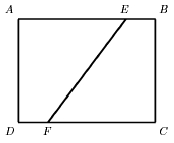48th MMPC Part II Problems
The top 985 students had 100 minutes to solve these five problems.
- The following figure represents a rectangular piece of paper
ABCD whose dimensions are 4 inches by 3 inches. When the paper
is folded along the line segment EF, the corners A and C coincide.
- Find the length of segment EF.
- Extend AD and EF so they meet at G. Find the area of the triangle AEG.

-
- Let p be a prime number. If a, b, c, and d are distinct
integers such that the equation
(x – a) (x – b) (x – c) (x – d) – p2 = 0
has an integer solution r, show that
(r – a) + (r – b) + (r – c) + (r – d) = 0.
- Show that r must be a double root of the equation
(x – a) (x – b) (x – c) (x – d) – p2 = 0.
- If sin x + sin y + sin z = 0 and cos x + cos y + cos z = 0, prove the following statements.
- cos (x – y) = –1/2
- cos (q – x) + cos (q – y) + cos (q – z) = 0, for any angle q.
- sin2 x + sin2 y + sin2 z = 3/2
-
- Construct an infinite collection { Ai } of infinite subsets of the set of
natural numbers such that | Ai ∩ Aj | = 0 for i ≠ j.
- (b) Construct an infinite collection { Bi } of infinite subsets of the
set of natural numbers such that | Bi ∩ Bj | gives a
distinct integer for every pair of i and j, i ≠ j.
- Consider the equation x5 + y5 = z5.
- Show that the equation has a solution where x, y, and z are positive integers.
- Show that the equation has infinitely many solutions where x, y, and
z are positive integers.
Back to the Spring
Newsletter
This page is maintained by Earl D. Fife
